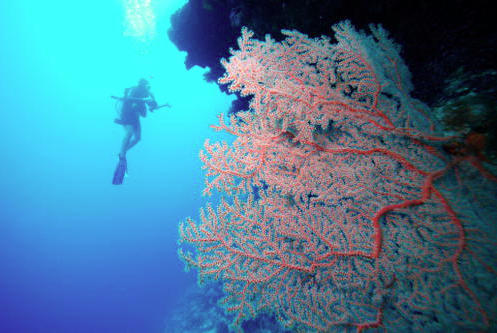Guide 4 – Case study: Great Barrier Reef (Australia)
Baseline situation
Coral reefs around the world are threatened both by natural and anthropogenic factors, with tourism having an important role in the latter. Direct impacts in coral reefs are related with badly managed tourism activities, such as snorkeling, diving, and sailing. Indirect impacts of tourism related to waste, pollution, and unsustainable uses of natural resources are also critical.
Along the coastline of the Great Barrier Reef, tourism is a major industry with up to two million visitors contributing greatly to local, regional, and national development. However, unlike other coral reef destinations around the world, in this World Heritage site, appropriate tourism management strategies have changed tourism from a threat in the past to a strong conservation ally in the present.
What did they do?
In 1997, tourism operators started collecting coral observations during their visits to the Great Barrier Reef and reporting them for analysis by the Marine Park Managers and scientific researchers. This data provided them with regular and up-to-date data on reef health status and tendencies, the presence of protected and iconic species, and early alerts of environmental impacts. This initiative, currently named ‘Eye on the Reef – Tourism Weekly Monitoring Programme', was the origin of the ‘Eye on the Reef Programme’, which now overarches this and three other sub-programmes, all aiming to monitor the health of the Great Barrier Reef through the participation of different key local stakeholders.
Strategic priorities
- To create synergies between tourism operations, conservation, research, and heritage management at the Great Barrier Reef.
- To increase knowledge and conservation awareness among the tourism businesses and promote their participation in the governance of the World Heritage site.
- To obtain regular, relevant long-term data about the ‘health’ of the Great Barrier Reef, which supports strategic, not reactive, management.
What worked?
- Establishing conditions for participation, including the commitment to survey the same reed site on a weekly basis at least 40 times per year, allowed site management authorities and researchers to collect relevant data, on a regular basis, and from specific reef locations.
- ‘Hiring’ tourism operators to carry out reef monitoring was a great idea – they are often the people who know the different reef sites best due to their regular, first hand tourist operations.
- Creating standard tools for collecting information (a survey form) and reporting information (single online data management and reporting system), made it possible to standardise the information coming from different sources.
- All participants receive a complete monitoring training, providing them with the capacities needed.
- While providing regular information to Marine Park Managers and scientists, tourism operators improve their knowledge and the quality of their tour management, reef interpretation, and tourism product design capacities.
What was tough?
One of the challenges of the ‘Eye on the Reef –Tourism Weekly Monitoring Programme’ was to make it easy for local tourism operators to participate, with monitoring training being a critical stage of the process.
How did get buy-in?
A three-step training programme was developed and adapted to the different schedules, backgrounds, and locations of tourism operators. This adaptability made it more feasible for them to participate. The first step was a two-hour online introduction to monitoring on the Great Barrier Reef. This was followed by two-hour workshops in different local areas four times a year, in which programme coordinators and guest researchers addressed important issues and present relevant topics regarding the Great Barrier Reef. The last part consisted of a full day of in-water training. Combining short online training sessions, nearby face-to-face training workshops, and the need to commit to just one day of full training, made the programme accessible for tourism operators.
What are the results?
The ‘Eye on the Reef — Tourism Weekly Monitoring Programme’, is one of the largest tourism-based coral reef monitoring collaborations on the planet.
The Reef Health Incident Response System allows the Great Barrier Reef Marine Park Authority to predict and detect reef health incidents such as coral bleaching, and act accordingly. This is made possible thanks to the information from ‘The Eye on the Reef — Tourism Weekly Monitoring Programme’.
What lessons can others take from this?
The Eye on the Reef – Tourism Weekly Monitoring Programme is an example of tourism businesses acting as conservational champions of the Outstanding Universal Value at World Heritage sites. It shows that appropriate, adapted, and flexible training programmes, combined with the development of innovative, participative monitoring tools and reporting platforms, can lead to a successful inclusion of tourism operators into monitoring and conservation strategies in World Heritage sites. This illustrates a huge potential in those World Heritage sites such as the Great Barrier Reef, whose large extensions mean they can only be monitored by relevant authorities' or scientists’ resources. Finally, it showcases how commitment and long term-cooperation between the tourism sector, scientists, and World Heritage management authorities can benefit the overall management performance of a World Heritage site.





